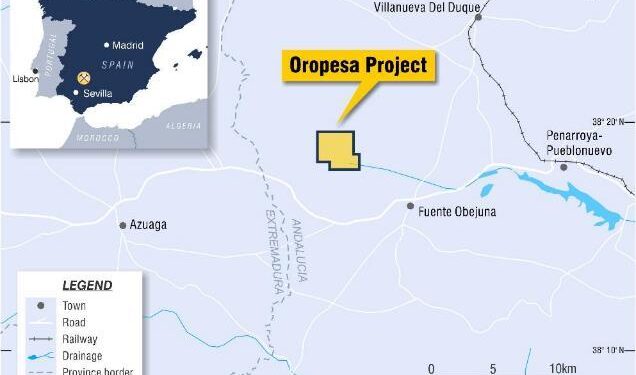Elementos Limited’s (ASX:ELT) Optimisation Study (JORC defined Scoping Study) for its Oropesa Tin Project in Spain has confirmed a robust case for upgrading the project scale to 1.25Mtpa Run of Mine (ROM) rate, with average annual contained tin production projected at 3,350tpa.
The Oropesa project economics are robust at a variety of tin price assumptions and discount rates as evidenced by the following table, with the Scoping Study tin price of US$32,500/t and the current cash tin price of US$42,650/t (LME) US$54,000/t (SHFE) highlighted for ease of comparison.
The Optimisation Study confirms a Production Target of 15.5Mt of RoM Ore at 0.37% Sn grade (including dilution) using a US$30,000/t mining pit shell revenue price and all operating costs re-estimated and updated to a 2022 cost base.
The Optimisation Study provides a significant increase from Elementos’ previous 2020 Updated Economic Study (750ktpa operation, US$92M NPV8, Pre-tax).
The increase in project scale includes increases to mining, ore sorting, processing and supporting infrastructure and is designed to comply with the Spanish mining and environmental regulations, including back-fill and rehabilitation of the open-pit.
Elementos has redesigned the mine to comply with all known environmental and mining licence regulations and restrictions, with a focus on minimising disturbed areas and environmental impact.
A major update to the prior Study is the design and costing of the back-fill and rehabilitation of the open pit, tailings dam, waste dumps and all project infrastructure.
This Study is fully aligned with the regulatory requirements planned for submission in April 2022. These regulatory submissions include both the Environmental Impact Assessment and Exploitation Licence application (Mining Licence).
Elementos will use the matured design and upgraded scale confirmed by the Optimisation Study as the basis for a Definitive Feasibility Study (DFS).
The Study also notes that using a pit-shell revenue price of US$45,000/t would likely add an extra two years of full production onto the mine life of the operation using available Mineral Resources, excluding any additional exploration potential.
At the base case tin revenue of US$32,500/tonne, the mine is forecast to generate an average annual gross revenue of US$108 million against a forecast operating cost of US$50 million per year and All-In-Sustaining-Cash (AISC) cost of US$18,607/tonne of metal.
The estimated capital development cost is US$86 million including a 20% contingency. Readily executable, the development proposes a modern open-cut mining operation, which backfills the pit progressively, and a conventional tin processing facility producing tin metal in concentrate which would be shipped to smelters in Europe and Asia.
“The Optimisation Study confirms that Oropesa will deliver a low capital-intensive project, with a competitive operational cost base, producing significant quantities of tin concentrate for at least 13 years,” Managing Director Joe David said.
“The operational and financial metrics summarised in this Optimisation Study are extremely positive. It demonstrates Oropesa’s potential to become a significant European tin operation, supplying material quantities of tin concentrate into the global supply chains during a period of unanticipated growth in demand to service the world’s insatiable appetite for critical electrical components.
“This Optimisation Study is now the basis for the company’s DFS and will be the basis of all the required regulatory submissions. The fact that the financial outcomes presented are incredibly strong when based on a design which we believe is conservative and complies with all required regulations has the company more motivated than ever. “Following recent mineralisation intercepts outside the current Mineral Resource limits, the company anticipates that the presented Optimisation Study will prove to be the first phase of a larger mining operation, with the company planning further Oropesa exploration programs at the appropriate time.”
Mr David said the Optimisation Study was presented at a level of accuracy of a JORC Scoping Study but several work streams in the Study have been completed to a more detailed standard of evaluation and definition.
“The Study, completed by a team of independent consultants, follows extensive drilling, geological, geotechnical, feasibility and metallurgical test work programs over more than 12 years,” he said.
For further information please visit: https://www.elementos.com.au/












